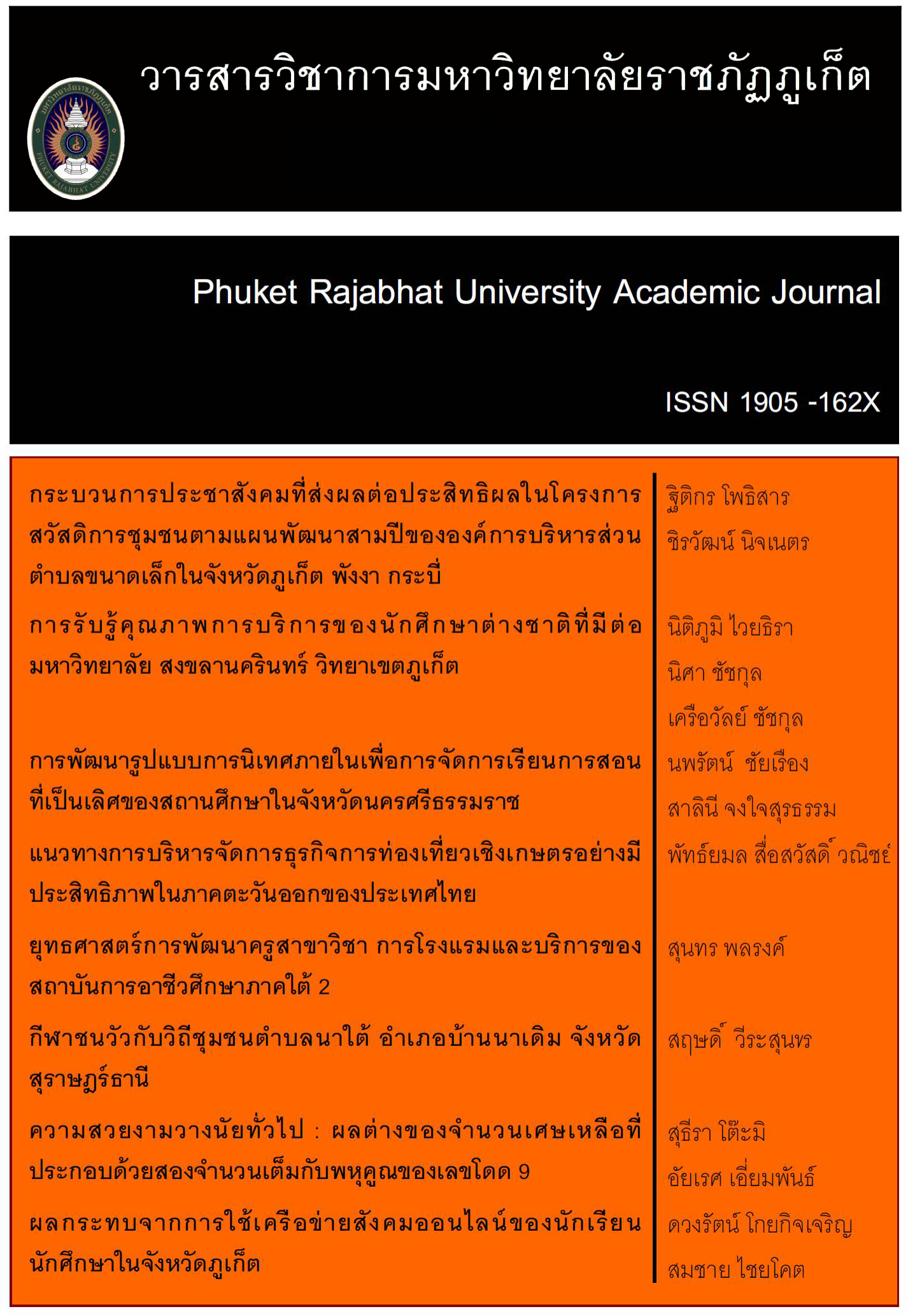การวิเคราะห์การจัดการท่าเรือแวะพักจังหวัดภูเก็ต สำหรับการท่องเที่ยวเรือสำราญ
Main Article Content
บทคัดย่อ
การศึกษาครั้งนี้มีวัตถุประสงค์เพื่อวิเคราะห์การจัดการท่าเรือแวะพักของจังหวัดภูเก็ตสำหรับการท่องเที่ยวเรือสำราญผ่านการวิเคราะห์ช่องว่างระหว่างระดับความสำคัญของการจัดการท่าเรือแวะพักและประสิทธิภาพการจัดการท่าเรือแวะพักของจังหวัดภูเก็ตในมุมมองของผู้โดยสารเรือสำราญ การวิจัยครั้งนี้เป็นการวิจัยเชิงปริมาณ โดยเก็บข้อมูลจากผู้โดยสารเรือสำราญจำนวน 562 คนที่เดินทางเข้ามากับเรือสำราญทั้งสี่ขนาดในจังหวัดภูเก็ตระหว่างเดือนพฤศจิกายนถึงเดือนธันวาคม พ.ศ. 2556 ผลการศึกษาพบว่า ความปลอดภัยบนฝั่ง สุขอนามัย ความสะอาด พิธีการตรวจคนเข้าเมืองและการผ่านพิธีการศุลกากร เสถียรภาพทางการเมือง มีระดับความสำคัญในการจัดการท่าเรือแวะพักสูงสุดตามลำดับ ในขณะที่ความร่วมมือระหว่างผู้มีส่วนได้ส่วนเสียในการจัดการท่าเรือ การยอมรับของสังคม ลักษณะเฉพาะของท่าเรือ นโยบายการท่องเที่ยวเรือสำราญ และสิ่งอำนวยความสะดวกสำหรับการท่องเที่ยว มีระดับความสำคัญในการจัดการท่าเรือแวะพักต่ำสุดตามลำดับ ในขณะที่ พิธีการตรวจคนเข้าเมืองและการผ่านพิธีการศุลกากร ผู้ให้บริการ แหล่งท่องเที่ยว ความคุ้มค่าเงิน สภาพอากาศและทะเล มีประสิทธิภาพในการจัดการท่าเรือแวะพักของจังหวัดภูเก็ตสูงสุดตามลำดับ ในทางตรงกันข้าม โครงสร้างพื้นฐานของท่าเรือ สิ่งอำนวยความสะดวกของท่าเรือ ความปลอดภัยบนฝั่ง นโยบายการท่องเที่ยวเรือสำราญ ความร่วมมือระหว่างผู้มีส่วนได้ส่วนเสียในการจัดการท่าเรือ มีระดับประสิทธิภาพ ในการจัดการท่าเรือแวะพักของจังหวัดภูเก็ตต่ำสุดตามลำดับ ที่สำคัญที่สุดจากการเปรียบเทียบระหว่างระดับความสำคัญในการจัดการท่าเรือแวะพักและประสิทธิภาพของการจัดเรือท่าเรือแวะพักของจังหวัดภูเก็ตพบว่า โครงสร้างพื้นฐานของท่าเรือ สิ่งอำนวยความสะดวกของท่าเรือ เสถียรภาพทางการเมือง มีช่องว่างกว้างที่สุดตามลำดับ ส่วนพิธีการตรวจคนเข้าเมืองและการผ่านพิธีการศุลกากร สภาพอากาศและทะเล และกิจกรรมการท่องเที่ยวมีช่องว่างน้อยที่สุดตามลำดับ ผลการศึกษาพบว่า โครงสร้างพื้นฐานของท่าเรือ สิ่งอำนวยความสะดวกของท่าเรือ และเสถียรภาพทางการเมืองมีความจำเป็นเร่งด่วนในการพัฒนาการจัดการท่าเรือแวะพักจังหวัดภูเก็ตสำหรับอุตสาหกรรมเรือสำราญ
Article Details
เนื้อหาและข้อมูลในบทความที่ลงตีพิมพ์ในวารสารวิชาการมหาวิทยาลัยราชภัฏภูเก็ต ถือเป็นข้อคิดเห็นและความรับผิดชอบของผู้เขียนบทความโดยตรง ซึ่งกองบรรณาธิการวาสารฯ ไม่จำเป็นต้องเห็นด้วยหรือร่วมรับผิดชอบใด ๆ
บทความ ข้อมูล เนื้อหา รูปภาพ ฯลฯ ที่ได้รับการตีพิมพ์ในวารสารวิชาการมหาวิทยาลัยราชภัฏภูเก็ต ถือเป็นลิขสิทธิ์ของวารสารวิชาการมหาวิทยาลัยราชภัฏภูเก็ต หากบุคคลหรือหน่วยงานใดต้องการนำทั้งหมดหรือส่วนหนึ่งส่วนใดไปเผยแพร่ต่อหรือเพื่อกระทำการใด ๆ จะต้องได้รับอนุญาตเป็นลายลักษณ์อักษรจากวารสารวิชาการมหาวิทยาลัยราชภัฏภูเก็ตก่อนเท่านั้น
References
ASEAN. (2002). ASEAN Cruise Development Framework. A Study for an Integrated Regional Cooperation Framework Plan.
Bateman, S. (2010). Maritime Capacity Building in the Asia-Pacific Region: Capacity Building for Maritime Security Cooperation: What are We Talking About?. Australian Maritime Affair. 30: 5-20.
Bayley, M. (2009). Global Cruise Industry “Strategy for Success in the Asian Cruise Market”. Royal Caribbean Cruises Ltd: 1-28.
Busby, G. & O’Neill, J. (2013). Port of Call: In Search of Competitive Advantage. European Journal of Tourist. 4 (1): 123-160.
CLIA. (2014). CLIA, 2014 State of the Cruise Industry Report. Cruise Line International Association.
Cruise Gateway North Sea. (2012). Decision Criteria for Cruise Port Selection in the North Sea Region. Cruise Gateway North Sea – Working Package 3 Study.
Demetriou, I. (2011). The Promotion of the New Larnaka Port as a Homeport for Cruises in the Wider Region of Eastern Mediterranean: Challenges, Perspectives and Specific Proposals. Maritime Institute of Eastern Mediterranean. pp.1-30.
Dowling, K. R. (2006). Cruise Ship Tourism. CAB international. London : Textbook.
Economic Commission for Latin America and the Caribbean (ECLAC). (2005).
Issues and Challenges in Caribbean Cruise Ship Tourism. Santiago, Chile: ECLAC.
European Commission. (2009). Tourist Facilities in Ports: The Economic Factor. Antwerp, Belgium: Policy Research Corporation.
Gibson, P. (2006). Cruise Operations Management. Burlington: Butterworth-Heinemann.
Hoogkamer, P. L. (2013). Assessing and Managing Cruise Ship Tourism in Historic Port Cities: Case Study Charleston, South Carolina. Master’s thesis, Columbia University.
Iraqi, I. M. (2006). Tourism services quality (TourServQual) in Egypt : The Viewpoints of External and Internal Customers. Benchmarking : An International Journal. 13 (4): 469-492.
Kizielewicz, J. (2012). Theoretical Considerations on Understanding of the Phenomenon of Maritime Tourism in Poland and the World. Scientific Journals. 31 (103): 186-116.
Lekakou, M. B.; Pallis, A. A., & Vaggelas, G. K. (2009). Which Homeport in Europe: The Cruise Industry’s Selection Criteria. Tourismos: An International Multidisciplinary Journal of Tourism. 4 (4): 215-240.
Liu, M. X. (2006). Customer Relationship Management in Asia/Pacific Cruise Industry. Master’s thesis, University of Nottingham.
Magala, M., & Sammons, A. (2008). A New Approach to Port Choice Modelling. Maritime Ecomomics & Logistics. 10 (1): 9-34.
McCalla, R. J. (1997). An Investigation into Site and Situation: Cruise Ship Port. Voor Economische en Sociale Geografie. 89 (1): 44-55.
Ogawa, Y., Tanase, Y., Nagayama, J., Higuchi, Y., & Yoshida, S. (2009). Promotion of Cruise Tourism: Promoting the Tourism Industry in the Future. Tourism Thesis.
Ontario Ministry of Tourism. (2006). Developing Shore Excursions for Great Lakes Cruises: A Workbook. Manual.
Parasuraman, A.; Zeithaml, V. A., & Berry, L. L. (1988). SERVQUAL: A multiple-item Scale for Measuring Consumer Perceptions of Service Quality. Journal of Retailing. 64 (1): 12-40.
PATA. (2011). The Cruise Industry in Asia Pacific. Issues and Trends (Pacific Asia Travel Association). 16 (2): 1-19.
Paithoon Monpanthong, & Therdchai Choibamroong, (2013). Challenges and Opportunities for a Port of Call Management in Cruise Industry in Phuket, Thailand. Pacific Tourism Association Annual Conference (APTA). 19 (127): 225-230.
Paithoon Monpanthong. (2003). The Marketing Development of Phuket's Tourism Industry to Encounter the Growth of Cruise Ship Operations. Master’s thesis, Prince of Songkla University.
Pavlic, I. (2013). Cruise Tourism Demand Forecasting – The Case Study of Dubrovnik. Tourism and Hospitality Management. 19 (1): 125-142.
Port-Net. (2007). Challenges and Future Trends: Ports and Passengers in Europe – The Baltic Range (Tallinn, Riga, Klaipeda and Kaliningrad). Port-Net Study 04-5. Prepared by Spinter Research and Instituto Internationale delle Comunicazioni.
Rodrigue, P.J., & Notteboom, T. (2012). The Cruise Industry: Itineraries, Not Destinations. Port Technology International. 1-4.
Tarlow, P.; Korstanje, E. M.; Amorin, E., & Gandara, G. M. J. (2012). Cruise Risks, Threats and Dangers: A Theory. American Journal of Tourism Research. 1 (2): 16-25.
TEC Inc. (2007). Port of Sydney Master Plan. In association with CBCL Limited Bermello Ajamil & Partners, Inc. Martin Associates.
Tonzon, J., & Heng, W. (2005). Port Privatization, Efficiency and Competitiveness: Some Empirical Evidence from Container Port (terminal). Transportation Research. Part A. 39: 405-424.
Tourism Queensland. (2006). Cruise Destination - A How to Guide. North Sydney: Thompson Clarke Shipping.
UNWTO. (2010). Cruise Tourism – Current Situation and Trends. Madrid: World Tourism Organization.
________. (2011). UNWTO World Tourism Barometer, 9. Madrid: UNWTO.
________. (2012). Asia Pacific Newsletter Issue 25. Madrid: UNWTO.
Wentworth, D. (2010). Economic Feasibility of Tawas Bay as a Cruise Ship Port of Call and Port City Guide. East Tawas, MI: Port of Call Committee and the City of East Tawas.
WGL. (2002). Developing Singapore into a Global Integrated Logistic Hub. Singapore: ERC Working Group on Logistics, International Enterprise Singapore.
Willis, R. (2012). Development of the Cruise Industry from a Global and Hong Kong Perspectives and Key Characteristics of Cruising. The Hong Kong Association of Travel Agents and International Travel Expo. 1-50.
Wu, B. (2005). The World Cruise Industry: A Profile of the Global Labor Market. Seafarers International Research Center (SIRC). Cardiff University.

